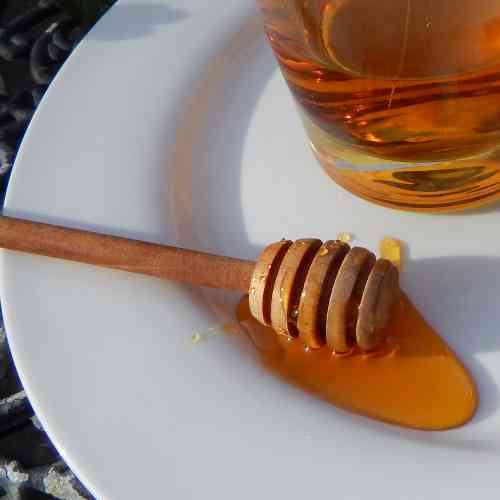Manuka Honey And Wound Healing
Honey has been used for thousands of years for wound healing and it is known to have anti-microbial properties. What is the evidence that manuka honey does actually improve wound healing?
Manuka Honey And Wound Healing - is there any evidence?

Tan et al; 2009
Tan et al (1) have shown that manuka honey and Malaysian tualang honey have a range of
antibacterial properties against a number of bacteria found in wounds. However, this was an ‘in vitro’ study that did not look at clinical activity (the effects
of the honey on actual symptoms in patients).
But studies have been carried out that show that honey (‘medihoney’ and manuka honey) can have a beneficial clinical effect in the treatment of leg ulcers, infected wounds and burns on actual patients.
For example:
Molan; 2006
Molan (2), in a review published in 2006 reported a total of 22
different clinical studies (17 of them fully randomized controlled studies)
involving over 2000 patients, that have demonstrated a positive clinical effect
for the use of honey to assist wound healing.
However, while some fully randomized studies show a beneficial effect, there are others which appear to suggest that it seems to depend on the precise organism associated with the infection.
Gethin and Cowman; 2008
Gethin and Cowman (3) showed a significantly better reduction of MRSA in leg ulcers by use of
manuka honey compared to the usual treatment (hydrogel). Other studies also indicate a positive effect of Manuka Honey on MRSA.
They state:
CONCLUSION:
Manuka honey was effective in eradicating MRSA from 70% of chronic venous ulcers. The potential to prevent infection is increased when wounds are desloughed and MRSA is eliminated. This can be beneficial to prevent cross-infection.
More evidence:
However, in the same study they showed that manuka honey was not as good at reducing Pseudomonas infection.
Karamatos et al; 2014
Karamatos et al (4) showed a significant clinical advantage to using manuka honey impregnated
dressings for the treatment of diabetic foot ulcers when compared to their
normal treatment using conventional dressings.
Robson et al; 2009
Robson et al (5)
showed a significantly better clinical outcome for honey dressings in
wounds compared to normal dressings.
They state:
CONCLUSION:
Wound area at start of treatment and sex are both highly statistically significant predictors of time to healing. These results support the proposition that there are clinical benefits from using honey in wound care, but further research is needed.
Other research investigating manuka honey & wound healing have shown
- a beneficial clinical effect for honey in wound
healing, but not necessarily better than the usual method (in contrast with the
findings of the Karamatos et al and Robson et al studies above).
- no clinical effect.
Jull et al; 2007
Jull et al (6) were unable to demonstrate any significant difference in the rates of leg ulcer
healing when comparing use of honey impregnated dressings and the normal
dressings use in the units involved in the study. In actual fact, the ‘honey’ treatment group
performed had better healing than the usual treatment group, but the
researchers note that the difference was not significant.
The study states:
“Of 368 participants, 187 were randomized to honey and 181 to usual care. At 12 weeks, 104 ulcers (55·6 per cent) in the honey-treated group and 90 (49·7 per cent) in the usual care group had healed (absolute increase 5·9 (95 per cent confidence interval (c.i.) − 4·3 to 15·7) per cent; P = 0·258). Treatment with honey was probably more expensive and associated with more adverse events (relative risk 1·3 (95 per cent c.i. 1·1 to 1·6); P = 0·013). There were no significant differences between the groups for other outcomes.”
Johnson et al; 2014
Johnson et al in The Lancet (7) showed no beneficial effect of using ‘medical honey’ to prevent catheter
–related infections in peritoneal dialysis over their normal therapy
(mupiracin). Unfortunately,11.6% of
the group using honey experienced some local infections, and there was an
increased risk of peritonitis in part of the ‘honey group’ which had diabetes.
Bardy et al; 2011
Bardy et al (8) in the British Journal of Maxillofacial Surgery investigated the effect of manuka honey in radiotherapy-induced mucositis
(that is painful inflammation of the mouth caused by radiotherapy to the head
and neck.
They concluded that active
manuka honey did not improve mucositis.
Studies for manuka honey and wound care involving small numbers of patients
There have also been a number of individual case studies reported in the medical press:
Natarajan et
al; 2009
Natarajan et
al (9) reported a single patient case
study in which manuka honey eradicated a MRSA leg infection. Other studies have found manuka honey to be
effective against MRSA, so perhaps it’s no surprise if manuka honey is
effective in wounds where MRSA is a key factor.
Visavadia et
al; 2008
Visavadia et al (10) report successfully using manuka honey impregnated dressings on their
maxillofacial unit.
Blaser et al; 2007
Blaser et al (11) reported full wound healing in seven patients with MRSA infected wounds –
infections that had previously not responded to treatment with antibiotics.
Robson & Cooper; 2009
Robson & Cooper (12) report successful use of manuka honey in patients with damaged skin due to
radiotherapy. The authors reported
complete healing of damaged skin areas.
REFS:
Copy and paste these links into your browser to see the studies:
(1) https://www.ncbi.nlm.nih.gov/pmc/articles/PMC2753561/
(2) http://journals.sagepub.com/doi/abs/
10.1177/1534734605286014
(3) https://www.ncbi.nlm.nih.gov/pubmed/18666717?dopt=Abstract
(4) https://www.ncbi.nlm.nih.gov/pubmed/22985336
(5) https://www.ncbi.nlm.nih.gov/pubmed/19222654?itool=EntrezSystem2.PEntrez.Pubmed.
Pubmed_ResultsPanel.Pubmed_RVDocSum&ordinalpos=4
(6) http://onlinelibrary.wiley.com/doi/10.1002/bjs.6059/
abstract;jsessionid=CAC703FE4DE498514385AFC8A3162C45.f02t02
(7) http://www.thelancet.com/pdfs/journals/laninf/PIIS1473-3099(13)70258-5.pdf
(8) https://www.ncbi.nlm.nih.gov/pubmed/21636188
(9) http://www.tandfonline.com/doi/abs/10.1080/
095466301750163563
(10)
https://www.ncbi.nlm.nih.gov/pubmed/17927079
(12) https://www.ncbi.nlm.nih.gov/pubmed/19174588
If you found this page helpful or interesting, I'd really be grateful if you would share it with others - if not this page, perhaps another, such as Gardening For Bees.
Thank you so much :) .